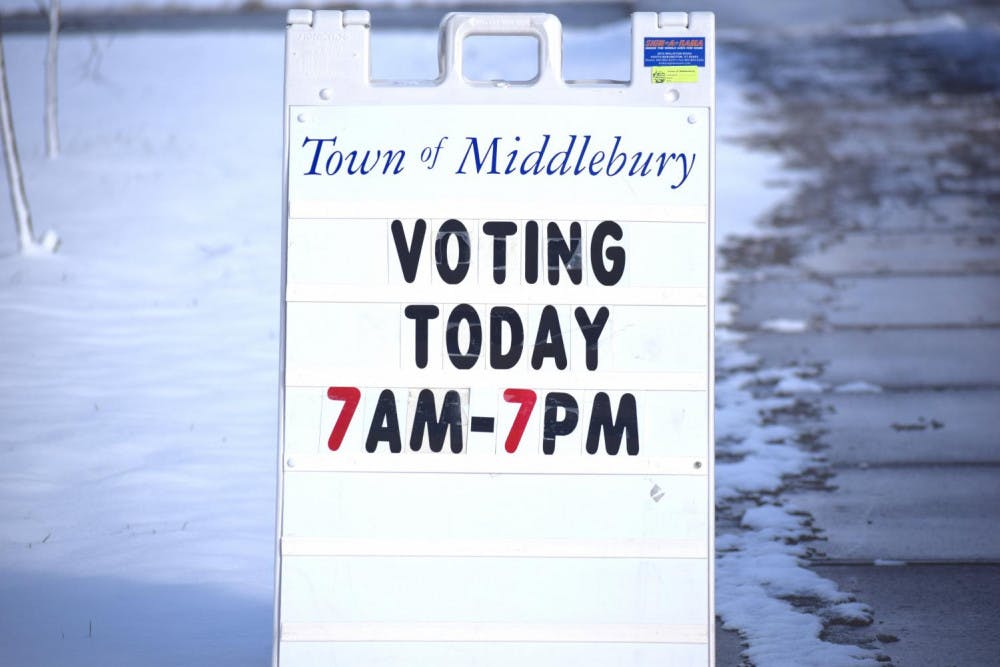As the nation waited on edge to hear the results of the 2020 presidential election, many of Middlebury’s students of color feared that tensions could erupt into racialized violence on campus and in town.
Students worried that the college, which hosts a much higher concentration of people of color than the surrounding area, would provide an easy target for racial violence and hate speech. Many students of color decided to stay on campus, travel in groups, avoid the main roads and town and remain hyper-vigilant for the duration of election week and beyond.
Jasmin Animas-Tapia ’21 made one last trip into town to stock up on groceries on Nov. 1. She worries that tensions will continue to mount over the coming weeks instead of dying down. Unless absolutely necessary, she does not plan on returning to town before she leaves for the end of the semester.
As a Black woman, Kaila Thomas ’21 believes she is an easier target for racial violence than male students of color. For the duration of election week, Thomas scarcely left her college housing except to attend in-person classes and eat in the dining hall. Friends escorted her to classes and sometimes brought her meals so she wouldn’t have to leave her refuge.
Many students of color did not fear outright physical violence in Vermont but worried that they might be verbally assaulted by passing cars or community members. The threat of these interactions undermines a sense of “emotional safety” for students of color, according to David Vargas ’22.5.
Vargas defined emotional safety as the feeling that he is wanted or belongs here, something he has felt infrequently during his time at Middlebury. Similarly, Animas-Tapia thinks about it as “feeling comfortable enough in spaces to be open and honest” about who she is.
None of these feelings and fears were new or unique to this election week. The election, and the rising national tensions that surround it, only serves to exacerbate existing worries for students of color, many of whom feel unsafe and uncomfortable in town even under normal circumstances.
Vargas is hyper aware of how his skin color visually marks him as an “outsider” in town. He remains constantly on guard, aware of his surroundings and thoughtful of his actions to avoid conflict when he leaves campus.
“Being Brown in America, you always have to be careful,” Vargas said.
Animas-Tapia carefully polices herself and her conduct when she enters the town. She tries to keep her head down and avoid calling attention to herself. She wears makeup and purposefully dresses up and tries to “look presentable.”
When she walks with her Spanish-speaking friends, she is careful to only speak English. Though it goes against her nature as a native New Yorker used to brusque interactions, she tries to appear overly friendly to passersby and cashiers in town.
“I’ll go out of my way to make small talk even if I'm not invested in the conversation just because, if I come to your store, I want you to recognize me,” she said. “I don’t want you to see me as a threat or as an outsider.”
Many students of color shared stories of facing racial harassment in Middlebury in the past. Vargas recalled a man shouting “Make America Great Again” at him as he rode by on a bicycle during his first semester. A man recently yelled “All Lives Matter” at Hennah Vohra ’21 out of the window of a passing car, and Animas-Tapia recalls freezing in shock when a white woman referred to her using a racial slur in Hannaford.
“I can’t remember her face anymore, and I never saw her again, but it was just something that really really stuck with me,” she said. “It just takes one moment to mess up the relationship [with the town].”
An “institutional memory” of past incidents also informs students’ fears, according to Vargas. A recent incident in which a white student used a racial slur against Rodney Adams ’21 looms heavily in many of their minds. Other past incidents, such as the appearance of stickers for a white supremicist organization on campus and white nationalist propaganda in Davis Family Library, all lend weight to students’ worries that they too could be targeted.
The college responded to students raising concerns about their safety during the election by organizing volunteer groups of faculty, staff, and community members to patrol the campus perimeter during the week. Patrols ran on Monday and Tuesday from 8 a.m. to midnight and from 6 p.m. to midnight for the rest of the week, according to Center for Community Engagement Assistant Director Jason Duquette-Hoffman, who organized the patrols.
Volunteers walked through the biting winds and blistering snow Monday night for over nine miles during their three-hour shifts, on the lookout for any outside agitators harassing students. Professor of Anthropology Michael Sheridan volunteered Thursday night, completing eight laps of the campus during his shift. At the end of the night, Sheridan’s Fitbit informed him that he had taken 21,000 steps.
“I thought it was wrong that anybody in our community should have to worry about their physical safety on our campus,” Sheridan said. “I saw this patrol idea as one way to contribute something to overall feelings of security and belonging in the community.”
According to Duquette-Hoffman, the volunteers were primarily meant to support students. Should something happen, they were told to follow the students' lead, but to try to support them and guide them away from the interaction rather than directly intervene. The college does not know of any incidents in the past week, according to Interim Director of Public Safety Daniel V. Giatto.
Duquette-Hoffman hoped that volunteers wouldn’t face any harassment and would instead spend their shifts enjoying a nice walk around campus and friendly conversations with students. He aimed for their presence to comfort nervous students and signal that the college cares about them and their fears. Many students of color said that they appreciated the volunteers’ efforts.
“BIPOC students on this campus often feel very isolated in the challenges we face,” Vohra said. “Knowing that our campus as a whole is finally cognizant of those is comforting.”
In addition to Public Safety increasing staffing on Monday and Tuesday nights, Middlebury also hired Green Mountain Concert Services (GMCS) to provide extra security during election week. Like the volunteer patrols, the college hoped that they could support students and guide them away from tense interactions should outside agitators approach them, according to Giatto.
GMCS’s presence raised concerns for students of color weary of security services and police in a time when the Black Lives Matter movement’s national prominence has put police brutality and racism at the forefront of people’s minds. Rather than alleviate her fears, GMCS staff only made Animas-Tapia more tense.
With no strong connection to the college or sense of the campus community, she worried about how they might interact with students. Should a student of color respond to harassment, she feared that GMCS staff might side with the initial attacker and cause further harm to the student.
The college’s lack of transparency heightened these concerns for some students. Though the college announced the volunteer patrols in a campus-wide email, they sent no communication about GMCS. Animas-Tapia only noticed their presence because their bright yellow jackets caught her eye.
Elijah Willig ’21 was also frustrated by the college’s lack of communication and failure to proactively address students’ concerns, noting that the college only organized volunteers and hired security after students of color repeatedly raised concerns about their safety. In his view, the college’s latest actions are part of a larger pattern of the administration reacting belatedly and insufficiently to the concerns of students of color.
“The administration only supports students when students demand that the administration supports them,” Willig said.
Animas-Tapia also wishes the college had reached out to students of color and directly asked them what they wanted and needed. A solution informed by their actual experiences would make students feel safer than GMCS or volunteer patrols, whose efforts she thinks are largely ineffective.
Those patrols do not enter dorms, nor do they monitor the everyday, small interactions where harms pile up, according to Animas-Tapia. While the fear of those interactions may die down as the election fades into memory, the threat will not disappear.
“This is not the only time you should prioritize keeping your students safe from harm,” she said. “It's not coddling your students; it's just giving them the peace of mind to know that they are safe here and to live happily and healthy.”
No amount of temporary security will effectively protect students of color on campus if the college does not directly address its role in perpetuating systemic racism, according to Vargas.
“It's all connected,” Vargas said. “If you don’t work hard enough to eradicate white supremacy and racism here, that's not really supporting people much with regard to the election. The election and the atmosphere here is just a byproduct of what's going on in the country overall.”
Editor’s Note: Professor of Anthropology Michael Sheridan is senior writer Sophia McDermott-Hughes’ academic advisor.

Sophia McDermott-Hughes ’23.5 (they/them) is an editor at large.
They previously served as a news editor and senior news writer.
McDermott-Hughes is a joint Arabic and anthropology and Arabic major.
Over the summer, they worked as a general assignment reporter at Morocco World News, the main English-language paper in Morocco.
In the summer of 2021 they reported for statewide digital newspaper VTDigger, focusing on issues relating to migrant workers and immigration.
In 2018 and 2019, McDermott-Hughes worked as a reporter on the Since Parkland Project, a partnership with the Trace and the Miami Herald, which chronicled the lives of the more than 1,200 children killed by gun violence in the United States in the year since the Marjory Stoneman Douglas High School shooting in Florida.




